PRESERVING CAPE HERITAGE AND CULTURE THROUGH EXPLORING VISUAL ARTS AND EDUCATION
The Guest: Bo-Kaap Barakah
Artist: Yasser Booley
Date: 5-14 December 2024 (Extended)
Venue: Habitus Wellness
61 Loop Street,
Cape Town

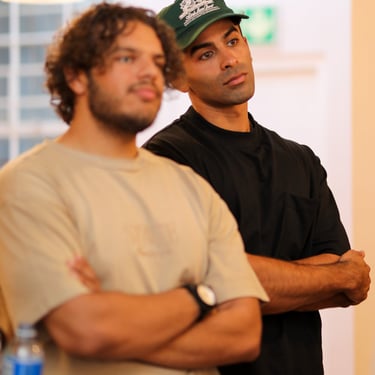
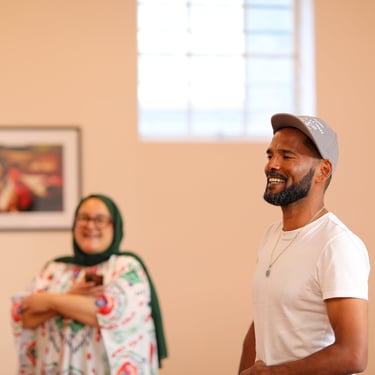
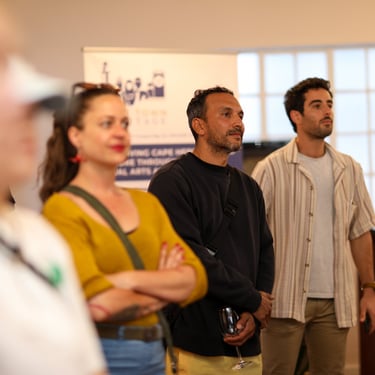
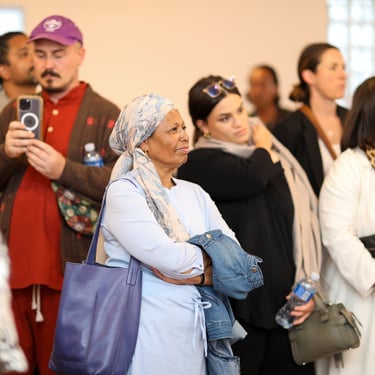
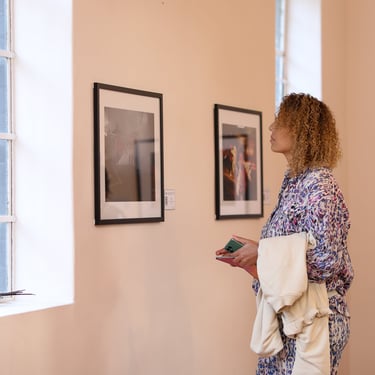


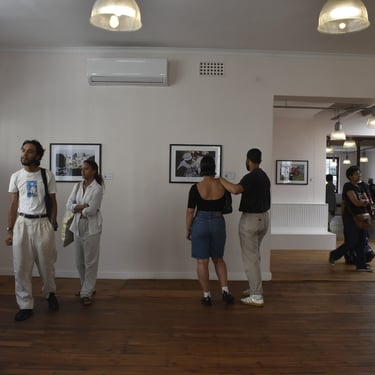
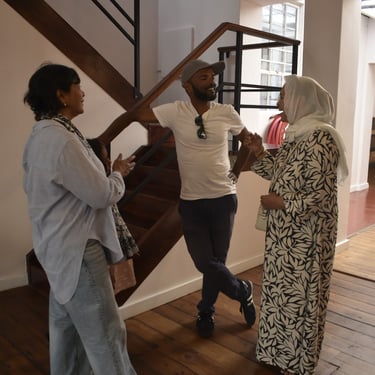

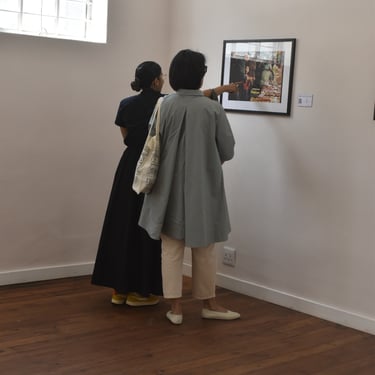


Located in the heart of the Cape Town CBD and bridging the gap between the City and the communities within them, the Habitus Wellness studio was transformed into an art gallery for this exhibition. The expansive area on the second floor, boasting high, wide windows that let natural light in, lent to beautiful lighting for the artist's work. The stark walls were beautifully decorated with Yasser Booley's poignant photographs capturing the essence of children in Bo-Kaap, while thoughtfully chosen minimalist props evoked a sense of nostalgia. This curated simplicity allowed the intricate details of the artwork to take center stage, inviting the audience to immerse themselves in the narratives and messages conveyed. Attendees were also encouraged to engage with the exhibition through audio stories linked via QR codes, where the photographer's voice narrated the significance of each image and its connection to the rich history of Bo-Kaap.
Aaliyah Ahmed,
OCTH Head Curator
Few places in South Africa showcase such a deep-rooted connection to a specific cultural bond that has been nurtured over many years, as seen in this unique area of Bo-Kaap, one of South Africa’s oldest communities, located on the scenic slopes of Signal Hill in Cape Town. “The Guest: Bo-Kaap Barakah” is an evocative exhibition that immerses audiences in the rich heritage of Bo-Kaap. Curated through the lens of photographer Yasser Booley, the exhibition showcases a range of photographs that pay homage to the community’s historical significance while addressing the contemporary challenges it faces. Booley’s photography captures the essence of childhood in Bo-Kaap, focusing on the daily lives of children. The images serve as a powerful reminder of the innocence and vibrancy of childhood within a nurturing community. However, they also highlight a stark contrast as children today increasingly find themselves thrust into protests, advocating for their community amid the pressures of gentrification.
The exhibition poses crucial questions about the future of cultural identity and heritage in Bo-Kaap. How will the values, beliefs, and traditions be preserved in the face of ongoing urban development? The phrase “it takes a village to raise a child” resonates deeply here, emphasizing the potential consequences of a fragmented community on the upbringing of its youth. As familiar faces are replaced by newcomers, the communal bonds that once defined Bo-Kaap are tested, challenging the very foundation of what it means to belong. At the heart of this exhibition is the concept of Barakah, which means ‘blessings’ in Arabic. Barakah can be described as “a spiritual force that brings increase to a person’s life without definite input” or “abundance and permanence of goodness.” This idea transcends mere nostalgia; it emphasizes the importance of community cohesion over individualism. Historically, Barakah has countered the isolating tendencies of individualism, reinforcing the belief that generosity and shared resources contribute to the community’s overall wellbeing. This ethos is particularly poignant in Bo-Kaap, where the values nurtured by ancestors are cherished and actively practiced by current residents.
Reflecting on a growing concern for the waning presence of Barakah in the community. As the neighbourhood faces the encroachment of gentrification, the essential qualities that have defined its identity are at risk. The longing for Barakah becomes more pronounced as younger generations navigate an environment that increasingly feels unfamiliar and restrictive. In a world where sharing resources is seen as a risk of personal loss, the exhibition invites contemplation on how the spirit of generosity can be preserved. As “guests” to the exhibition, audiences are encouraged to reflect on their understanding of the images presented. Are we merely observers, or can we recognize the deeper narratives at play? The influx of newcomers, while bringing diversity and integration, also poses a threat to the continuity of Bo-Kaap’s vibrant culture. This duality is explored through the lens of hospitality, a cornerstone of the community’s identity.
The impact of gentrification on the innocence of youth is poignantly captured in Booley’s work. The neighbourhood, once a haven for dreams and play, now grapples with the realities of progress. The exhibition serves as a reminder of the values cultivated by generations, illustrating that the essence of Bo-Kaap is interwoven with its cultural practices and shared experiences. Through this exhibition, the community’s efforts to safeguard its heritage are highlighted, underscoring the delicate balance between welcoming newcomers and preserving its unique identity. The various roles that “guests” play in this context are examined, emphasizing the significance of maintaining the foundational values that have shaped Bo-Kaap. In honouring these principles, the exhibition pays tribute to the community’s heritage and paves the way for a future where every voice is valued and every narrative is recognized. This commitment to cultural continuity enriches the collective identity of Bo-Kaap, fostering a profound sense of belonging among its residents.
Ultimately, “The Guest: Bo-Kaap Barakah” challenges viewers to reconsider their understanding of community, hospitality, and the interconnectedness of lives within a shared space. By embracing the spirit of Barakah, we can cultivate a deeper understanding of mutual care and support, countering the isolating narratives that often dominate contemporary society. The exhibition stands as a testament to the enduring power of community and the vital role it plays in shaping our identities and futures.
The Archives
HISTORY OF BO-KAAP
The Bo-kaap, known for its rich history and distinctive architecture, stands as a remarkable exception in the landscape of apartheid-era Cape Town. This vibrant district has maintained its identity as a home for Cape Muslims and people of color, unlike many other neighborhoods in the central business district that have faced demolition or gentrification, leading to the displacement of long-time residents. The heart of Bo-Kaap, often referred to as the Old Malay Quarter, serves as a vital hub for the Cape Muslim community. Few places in South Africa showcase such a deep-rooted connection to a specific cultural group, a bond that has been nurtured over many years, as seen in this unique area of Bo-Kaap. Despite being invaded by the Dutch East Indies Company in 1652, it wasn't until 1658 that land grants for permanent settlement in Cape Town were issued. In 1760, Jan de Waal, the sexton of the Groote Kerk, acquired the land that would later be known as Bo-Kaap. Between 1763 and 1768, he built several small rental homes on the slopes of Signal Hill, which he rented out to freed Muslim slaves and “free” black individuals. Life for slaves was incredibly harsh, with the threat of severe punishments, including brutal whippings and public burnings with hot tongs for disobedience. Yet, despite these adversities, the Bo-Kaap community showed remarkable resilience and determination.
During the 17th and 18th centuries, designated spaces called ‘langars’ were commonly used by Muslims for their daily prayers and the Mawlud celebration. Although the sword-wielding "ratiep" (known as “Khalifa” during this time) has been met with criticism and is viewed negatively by some, it acted as a unifying emblem for the community. The 18th century saw the establishment of slave lodges in the area, which ultimately disappeared after the British government abolished slavery in 1834. This era also experienced a significant increase in the construction of affordable rental housing, particularly low-cost options, which expanded rapidly after 1840. As the 18th century drew to a close, records reveal that a Muslim man named Coridon from Ceylon had ownership of real estate, a rare occurrence at that time. However, this was not the norm, as studies show that the Burgher Senate opposed the goals of non-white individuals.
The properties on Dorp Street, particularly the house and mosque at numbers 42 and 43, which have seen various designations over the years, were acquired by Coridon van Ceylon (who had been manumitted from slavery by Trijn) on September 26, 1794. Coridon is recognized in his will, dated October 7, 1797, as the first Muslim property owner in Cape Town. After his death, his wife, Trijn van de Kaap, inherited the properties as outlined in his will. Both Trijn and her daughter, Saartjie, were former slaves who had belonged to Gerhardus Hendrick Craywagen before 1779. That year, Craywagen sought to free Trijn and her daughter, Sara, who was just four years old at the time. Trijn van de Kaap exhibited remarkable business skills; records from the Wykmeesters Returns for 1800 in the Cape Archives show that she owned her own property on Dorp Street, and had four slaves. She also provided lodging for four male and one female slave owned by Heer van Oudtshoorn. Saartjie and her husband, Job van Bengalen (possibly Achmat van Bengalen), along with their three children, lived on Trijn's property. Given the ages of their children, it can be assumed that Trijn and Achmat were married by 1800. On February 13, 1809, Trijn sold her late husband’s properties to her daughter, Saartjie, for 3000 guilders. This was a remarkable act for a woman to perform during her marriage, and Saartjie’s identity as a Muslim made this event even more significant for that era.
Saartjie van de Kaap is a remarkable figure in history, particularly within the Cape Muslim community. Born into slavery, she played a vital yet often overlooked role in supporting the community's faith. Her vision helped ensure that the Auwal Masjid became a cornerstone for Cape Muslims, fostering the growth of their beliefs in the Western Cape. The Masjid, which was originally constructed in 1794 and expanded in 1807, featured a mihrāb (niche) to indicate the qiblah, transforming a warehouse into a sacred space. Established during a time of slavery, the Masjid emerged amidst significant social and political challenges. The Auwal Masjid carries significant cultural weight, reflecting its connections to living heritage, its historical associations with slavery, and its role within the community. It is of particular importance to the Muslim population and is closely tied to notable figures like Tuan Guru, Achmat van Bengalen, and Saartjie van die Kaap. This mosque stands as a tribute to the efforts of Cape Muslims in their fight for recognition of their faith and the freedom to worship. Its significance is rooted mainly in its function as a sacred space, rather than its aesthetic or architectural qualities. As the first mosque in South Africa, the Auwal Masjid is a distinguished symbol of the South African Muslim community.
In the early 1930s, Cape Town launched a strong initiative to address ‘slum’ conditions. Determining what qualifies as a slum can often be a matter of personal judgment, leading to considerable differences in opinion among various observers. The Cape Times, along with other liberal media outlets, was notably outspoken in criticizing the living conditions in various neighborhoods. In 1933, they launched an investigative series that brought to light the severe hardships experienced by people in the city's most disadvantaged areas. At that time, the conversation around sanitation underscored the troubling plight of residents on the lower slopes of Signal Hill, particularly in Bo-Kaap. In 1934, the local government categorized the Malay Quarter as a "slum" in accordance with the Slums Act, highlighting the poor state of many homes in the area. Following this, the Group Areas Act specifically allocated Bo-Kaap for "Muslim Malays." The understanding of what makes an area a slum can vary greatly among different groups. This is particularly evident in the contrasting views on Bo-Kaap.
Key individuals, such as representatives from the Cape Town Municipality, participated in the discussion. Bishop Lavis highlighted the relationship between unemployment and poor housing conditions, claiming that removing ‘slums’ could improve public health in Cape Town by 30 percent, audaciously connecting the high rates of illness among Europeans to the living situations in ‘slums’, as seen through the experiences of domestic workers. The Slums Act had significant implications, as it allowed local authorities to classify a property as a slum and subsequently acquire it by compensating only for the land's value. Consequently, the Cape Town City Council (CCC) initiated the purchase of nearby properties at reduced prices beginning in 1936. The full scope of the unsanitary and hazardous conditions in Bo-kaap remains unclear. Evidence suggests that not all residences were in a state of disrepair. For instance, J. Hardie Stewen observed that the housing conditions were not entirely poor, stating, "The actual construction of the buildings is not always rotten."
The continued existence of various buildings without renovation until well into the 1970s and 1980s, paired with the CCC's delays in making decisions about their demolition and preservation, supports this argument. However, the entire area was regarded as a slum, which kept property prices notably low. As a result, the CCC was able to purchase most of the Old Malay Quarter and the vacant triangular section known as Schotschekloof at a very advantageous price. By the end of 1937, the CCC had emerged as the largest slum landlord not only in Bo-kaap but across all of Cape Town. There was a significant amount of resistance to the acquisition of properties. Many owners took it upon themselves to make repairs in an effort to keep their homes, but the CCC's gradual acquisition of slum areas made the process inevitable. The time lag between the demolition of these areas and the development of new housing left many displaced individuals without suitable options. A mother from Bo-Kaap poignantly shared her experience: “I have tried everywhere round here, but there is nowhere. They want to charge 165 and 175 6d a month rent, but I cannot pay that. Here I pay 6s 6d.”
During the 1930s, when the Bo-Kaap was first labeled a slum, its inhabitants were uniformly regarded as “degenerate”, with no distinctions made among them. The concept of 'Malayism' began to take shape in the 1940s, largely promoted by I.D. du Plessis, who aimed to separate Cape Muslims from other non-white communities in Cape Town. Drawing on his background as an Afrikaner intellectual during the rise of Afrikaner nationalism, du Plessis positioned himself as a protector of the 'Malays', understanding the importance of creating a unique identity. He played a crucial role in defining and elevating the identity of Cape Muslims, instilling in them a sense of 'Malayness' that he used to establish a perception of 'Malay otherness.' Additionally, various writers and commentators in the late 1930s and early 1940s contributed to the image of the Cape Muslim community as 'peaceful and law-abiding,' often depicting them as submissive to the ruling powers. Although Cape Muslims experienced the same oppressive conditions as other non-white groups, through the lens of 'Malayness' they were indoctrinated into believing they were the 'elite of the coloured people’ by white authority seeking to further separate and conquer. This belief seeked to nurture a sense of compliance with white authority, which facilitated a divide-and-rule approach in the local context. There was a notion that fostering a distinct and seemingly superior identity for Cape Muslims would help mitigate the perceived threat they posed to the colonial order. Yet, despite this strategy, the community's spirit of unity prevailed, as they stood against the injustices and atrocities of colonialism and apartheid, demonstrating their strength and resilience.
CURATORIAL STATEMENT
After an extensive examination of an array of photographs by Yasser Booley, the Head Curator at OCTH, Aaliyah Ahmed faced the intricate challenge of selecting images that would authentically narrate the story of Bo-Kaap. With a wealth of over a hundred images at her fingertips, she meticulously curated a collection of approximately twenty photographs and conceptualized the exhibition that vividly captured the neighbourhood's vibrant spirit. The selection aimed to celebrate the rich cultural heritage and identity of the community and sought to create a unified narrative that resonates with both residents and visitors alike. Among the chosen images, Aaliyah was particularly captivated by striking portraits of a child, which encapsulated the essence of the community. These photographs reflected the innocence and joy of youth, set against the backdrop of Bo-Kaap's iconic colorful architecture and bustling streets. By centering the narrative around a child, she highlighted the crucial role of future generations in preserving the cultural legacy of the area, serving as a poignant reminder of the community's resilience and the enduring connection between its past, present and future. The rest of OCTH team dedicated their efforts to researching the rich history of Bo-Kaap, aiming to complement the visual storytelling with a deeper understanding of the neighbourhood's history and significance. The research was essential in providing context for the exhibition, allowing visitors to appreciate the cultural nuances that define Bo-Kaap. Additionally, the team focused on the logistical aspects of the exhibition, which included securing an appropriate venue, set design that would do justice to the artwork and finding sponsors to support the printing of the selected photographs. The collaborative efforts were geared towards creating an immersive experience that showcased Booley's work and also educated the audience about the historical and cultural importance of Bo-Kaap. Through this comprehensive approach, the team aimed to ensure that the exhibition would celebrate the neighbourhood's unique character and provide a deeper appreciation for its heritage among all who attend.
Discover
Contact Us
Our cultural heritage matters
Help us learn and grow by sharing your respectful feedback on our website, exhibitions, social media and more:
Store's Terms and Conditions
